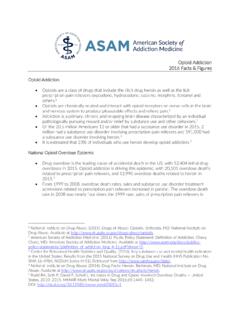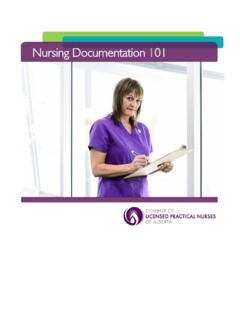Transcription of Slips and Trips Workplace Newsletter - Health and Safety ...
1 Heard the one about the woman whoslipped on a grape? She broke amajor bone in her leg and will alwaysneed a walking stick. Geddit?Thought not. It's not the slightest bitfunny - so why are Slips and Trips stilllooked upon as a bit of a joke?Far from being funny, slip and tripaccidents are a very serious problem,particularly in the Health servicessector where they account for 48% ofall reported major injuries. They alsoaccount for three times more majorinjuries than manual handling andassault/violence. In fact Slips and Trips are the mostcommon cause of major injuries at workgenerally. They occur in almost allworkplaces with 95% of major slipsresulting in broken bones. They can alsobe the initial cause of a range of otheraccident types, such as falls from costs of Slips and Trips areenormous. It was estimated in 2003 thatthey cost employers over 500 m andsociety over 800 m every and Trips are the most commonform of major injury affecting nurses,care assistants, assistant nurses,housekeeper/caretakers, ambulancestaff and cleaner/domestic main causes behind suchaccidents are: slipping on a surface that is wetor contaminated with anothersubstance; tripping over an obstruction; slipping or tripping on surfacessuch as steps, ramps,pavementsand roads.
2 Tripping over an uneven it's not just workers who slip up,members of the public (which includespatients) are also at risk, with almost62% of major injuries being caused byslips and , many employers regardslips and Trips as being outside their control, inevitable or theemployee's and TripsWorkplace NewsletterA Newsletter for employees in the Health servicesIt s time to take Slips and Trips seriouslyBut they are wrong. The solutions toslip and trip hazards are oftensimple and cost-effective. Forexample, from 1990 a concerted effortwas made to reduce Slips and tripsaccidents in food-processingindustries. The result was a 16%reduction overall, with a 19%reduction in major injuries since similar effort now needs to be madein the Health services both to reducethe impact upon staff, and to reducethe numbers of injuries to patientsand information on Health servicesaccident statistics can be found by visiting the website tip:wear suitable footwear2 Slips Assessment Tool (SAT)A frequently asked question when facedwith the task of completing a riskassessment is 'Where do I start?
3 '.For slip risks there is now an and HSL have developed a tooldesigned to help users risk-assess sliphazards in their Workplace . The SAT( slip Assessment Tool) is made up oftwo parts: a computer programme -which can be downloaded from theHSE Slips and Trips website - and aroughness used together, they will allowyou to produce a quantitative estimateof the slip risk on different types offloor, in particular of the SAT is not mandatory; it issimply an aid to help you assessslip risks in your use the tool, you will need tocollect detailed information about theworking area to be assessed, ie whatmaterial the floor is made from andwhat type of cleaning system is will also need data such as typeand amount of floor contaminants. For a true estimate you will also needto take a series of measurements of floor micro-roughness at a testlocation using a small hand-heldroughness can either record the data on aproforma and transfer it to a computerin your office or, if you have a laptop,you can preload it with SATsoftware and input the data directly foran immediate result.
4 The endproduct is an estimate of what the sliprisk is at that particular useful feature of the SAT is that you can change the variables youhave entered so you can see what might lower the slip risk. For example, you may find thatchanging the variable on thecleaning method used may result in the slip risk the risk:a new tool to helpManaging sickness absence and return to workManaging sickness absence and return to workUsing ladders and stepladders safely: A toolbox talkSlips and Trips Workplace NewsletterTop tip:clean up spills immediatelyHere are some examplesof roughness one of these withthe computer programmewill help give a trueestimate of slip risks ondifferent types of and Trips :the facts and figuresManaging sickness absence and return to workUsing ladders and stepladders safely: A toolbox talkSlips and Trips are the most common cause of major injuries at work.
5 They happen in almost all workplaces. In 95% ofcases involving a a major slip , the result is broken bones. Slips and Trips can also be the initial causes for a range of otheraccident types such as falls from height. On average, every year slip and tripaccidents account for:2 fatalities a yearIncalculable human costA 133 million annual billto the Health serviceAn annual bill of 512 millionto employers50% of all reported accidentsto members of the public20% of over-3-day injuries33% of all reported majorinjuries4 slip accidents cost hospitalemployee her footThe decomposing leaves lookedinnnocent enough but they ended upcosting Alison, an OccupationalTherapist her the leaves would have beencleared daily but there was a staffshortage and so the job wasn't was climbing the concretesteps to the hospital entrance whenshe slipt and fell heavily onto herright fall caused damage to the kneecapand she eventually needed returned to work but a fewyears later slipped again.
6 Snow wasfalling when she entered the hospitalbuilding to start work. The doormat,which was used by up to 100 staffand patients, was too small for thearea of tiled floor. It did not have thecapacity to absorb all of the waterbeing brought in by of the water was beingtransferred onto the dry changing out of her boots, Alison left her office and slipped on the wet floor. Although someone hadmopped it, they hadn't dried it orplaced barriers or warning signs. Alison fell directly onto her right ankle,which broke and became contorted. It was placed in plaster but the plasterwas taken off after only three weeksas the foot remained the next few years she had tohave 32 operations to try to save herfoot. Eventually, she was told that shehad dystonia caused by the accidentand amputation was the only solutionas her toes had by now lost theirfeeling and were turning said: The effect of these slipshas been horrendous.
7 When I had myfirst accident I was an active, newlymarried 21-year-old. Until my secondaccident I remained working andenjoyed dancing, aerobics, andjogging, but now I spend a lot of mytime in a wheelchair. Although I have receivedcompensation, I have lost my job and,due to ongoing problems, I'll neverwork again. My husband has also losthis business because he now has tocare for me. No amount of money cancompensate or prepare me for whathas happened. By the way, one week after my fall,the floors in the unit were madenon- slip . Isle of Wight NHS Trustreduces slip and tripaccidentsThe Isle of Wight NHS Trust hasmanaged to reduce its slip and tripaccident rates by a huge , how did they do it?It's no big secret really. They mainlyused a bit of common but critical changes were madefollowing risk assessments such as: Ensuring warning signs werealways used when floors werebeing washed.
8 Cleaning schedules were alteredso as not to coincide with thepeak activity times. Thinking ahead and putting downgrit in advance of any frost. Cleaners were encouraged towarn nearby workers before theystarted any work which couldcreate a slip or trip Newsletter for employees in the Health serviceCase study Case study Managing sickness absence and return to workManaging sickness absence and return to workUsing ladders and stepladders safely: A toolbox talkSlips and Trips Workplace Newsletter21 Top tip:dry floors after cleaningOver a three-year period, theOccupational Health and SafetyDepartment improved the quality ofthe Slips and Trips risk assessmentswithin the trust. At the same time, theyalso raised the staff's generalawareness of the issue. It wasrecognised that if re occurringincidents were to be prevented,incident recording systems needed tobe modified as Slips and Trips wereclassed as one category although thecauses were generally the quality of the floor surfaces aswell as the standard and timing ofthe cleaning is considered to presentminimal risk of slipping and trippingto staff.
9 This common sense approachhas reaped great rewards as the Isle ofWight NHS Trust saw a 40% decreasein slip and trip reported incidents in thetwo-year period since the icing on the cake? They won anaward in the HSE/Department ofHealth, Health Education Authority'Working Well Together' Awards in floor required adifferent cleaning regime,but did anyone tell thecleaners? Health and Safety managers in ahospital decided that they needed toreplace an old floor in a kitchen areafollowing a number of slippingaccidents. They opted for a newbespoke epoxy-based floor withspecialist anti- slip floor was laid but soon after theflooring supplier was asked to visitthe site because they were havingproblems keeping the floor supplier was surprised to find thefloor was stained in various areasand generally didn't look very discussed the problem with thecleaners who said that not only wasthe new floor extremely difficult toclean, but it was becoming slippery inparts and was damaging their sickness absence and return to workUsing ladders and stepladders safely: A toolbox talkCase study 3 The supplier discovered that thecleaning instructions for the new floorwere not being followed.
10 (Instead theywere filed on a shelf in the healthand Safety manager's office!)So the supplier asked for a stiff brushand a bucket of warm water with theappropriate amount of cleaningdetergent and then set to work. Hemerely swilled the cleaning solutionacross the floor, leaned on his brush fora few moments and then brushed awaythe dirty liquid. The supplier explainedthat if the floor was not cleaned properlyit would lose its slip -resistant cleaners were amazed to see thatalmost immediately the stains werelifted from the surface and the originalfloor colour had this could have been avoided ifsomeone had bothered to tell thecleaners about the appropriatecleaning regime for the new floor!Top tip:avoid trailing cables6 Cutting costs can proveexpensiveA Midlands business wanted to cutcosts. They decided that theirovernight cleaning operation could beprovided for less cost if carried outfirst thing in the the change, a number ofslipping accidents happened near tothe entrance of the transpired that the entrance mats,which had been cleaned using a wetcleaning process, were still dampwhen people first entered the that the mats were damp,visitors would then step onto thesmooth floor with wet has shown that tinyamounts of liquid on some smoothfloors can have a dramatic effect onthe floor owner quickly reinstated theovernight cleaning regime so thatfloors and entrance mats werecompletely dry well before s one of the easiest mistakes to accidentally spill some coffee orwater onto a smooth floor at work.















